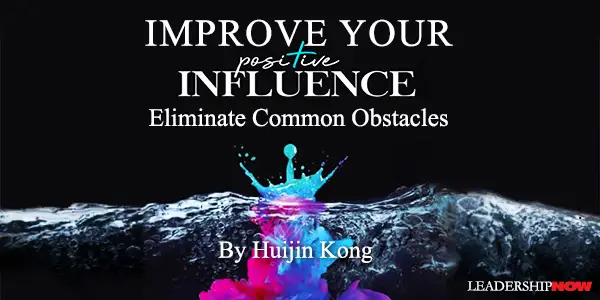 |
 |
10.27.23

Improve Your Positive Influence: Eliminate Common Obstacles
I FIRST encountered this equation in the context of peak performance in the sports world. The interference could come externally but often comes internally in an athlete — freezing up or choking on the spot. Yet others are able to push through interference from pressure or pain to realize their potential for top performance. The equation also applies to our individual capacity for positive influence (+influence). We all have the potential to have a lot more +influence if we address the common obstacles that interfere with achieving our +influence attempts. When the stakes are low — say, we botched the chance to change seats with another passenger on a plane — it’s not a disaster. However, in high-stakes situations, our doubts, self-talk, low awareness, ill-preparedness, and instinct-led execution can make or break our attempts. But with proper investigation and preparation, we can significantly reduce these drawbacks. This means not only making changes in our techniques but also becoming aware of how our internal interference unconsciously limits our choice of approach and, therefore, our impact on others. Here are common obstacles to our ability to have a +influence, along with how to minimize their interference: 1. Doubts. When the solution to a problem isn’t evident, and others don’t seem motivated to investigate one, a sense of futility can set in. It’s very easy to have what CEO Seah Chin Siong of the Singapore Institute of Management calls “goal erosion,” defining it as “Doing what is easy, going through the motions, but not doing the hard things the ultimate mission requires.” While it seems that no one person alone has the power to impact the situation, each person can make an attempt to have +influence. Acknowledging the current reality, including the issues, is a powerful first step. People also tend to give up too early or to not try because of an assumption that may not be valid. Most endeavors struggle with a number of challenges — technical, social, and political. The more ambitious the project, the greater the obstacles. Many people let these challenges and obstacles stop them in their tracks rather than perceive them as inevitable steps to work through. This is especially so when it comes to personal, interpersonal, or organizational issues, which are less straightforward to address. For example, we could be concerned with getting too personal (whether it’s our place to ask, whether she might be offended, and so on). While well-intended, this and other concerns are common obstacles that stop necessary conversations and attempts at +influence from occurring. 2. Self-talk. We have a lot of internal conversations occurring in our heads. The intent of our self-talk is to prepare and process, but it’s not necessarily oriented toward achieving +outcomes. A lot of self-talk is intended to keep us safe and to be considerate of others’ feelings, but it doesn’t prioritize what will raise productivity, satisfaction, and growth for ourselves, others, and the project or company. These instincts need to be interpreted, reconciled, and directed by the command center of our brain to determine the best way forward. If the command center is misdirected, we might over or under influence. When self-talk is linked to the relationship we think we have with the person, a narrowly defined relationship can limit our legitimate influence attempts. If it’s too broad, it may cause us to over-reach. 3. Low awareness. Insufficient awareness, especially of pressures that impinge on the key people who need to think, feel, and act in order for the positive outcome to be achieved, can lead to ineffective or counterproductive influence attempts. For example, a CEO might face pressure from investors and from the board chair, and influence attempts recognizing both will be more effective than something that recognizes only the more vocal concerns. The insightful +influence warrior identifies the key pressure points and then designs influence strategies that relieve that pressure in order to align others to the outcomes. 4. Ill-preparedness. Most people worry and agonize over issues and challenging conversations but don’t necessarily put in the time to prepare for the conversation. Rehearsing the presentation is a far cry from proper preparation for making a +influence. More is needed, including gathering information on the people involved, determining where conflicts may arise, and identifying their possible solutions. Sufficient preparation can more than double the effectiveness of a challenging +influence attempt. A conversation with each stakeholder concerning pressure points and interests can inform any influence attempts. The higher the stakes, the more systematic analysis and preparation will be needed. 5. Instinct-led execution. Instincts are our “innate, typically fixed pattern of behavior in response to certain stimuli.” They’re powerful but can also be misguided. They enable us to respond instantaneously to danger and opportunity but are problematic when the situation or stakeholders differ from those past situations. Following our initial instincts can result in avoidable mistakes. These days, it’s safe to assume that our current or future challenges are unlike those from the past. The people around us are different, and the issues we confront are likely to be more complex. Like it or not, we need to deal with diverse, conflicting, and challenging contexts. For example, American culture often finds confronting a conflict acceptable, but many Asian cultures, for example, might be offended by a direct confrontation. Instincts aren’t always necessarily right or wrong. Take the time to sense more deeply what’s really going on and consider different ways to address the situation. The best solutions inevitably leverage logic and emotion to have +influence on ourselves and others. To find out your +influence effectiveness, take this simple +influence assessment.  
Posted by Michael McKinney at 06:04 AM
|
BUILD YOUR KNOWLEDGE


How to Do Your Start-Up Right STRAIGHT TALK FOR START-UPS 
Grow Your Leadership Skills NEW AND UPCOMING LEADERSHIP BOOKS 
Leadership Minute BITE-SIZE CONCEPTS YOU CAN CHEW ON 
Classic Leadership Books BOOKS TO READ BEFORE YOU LEAD |